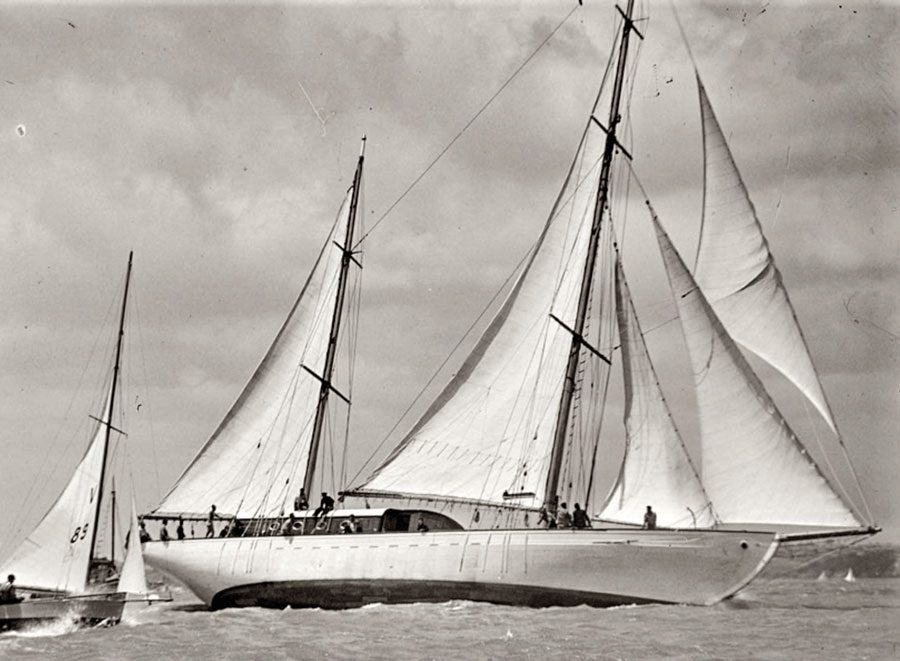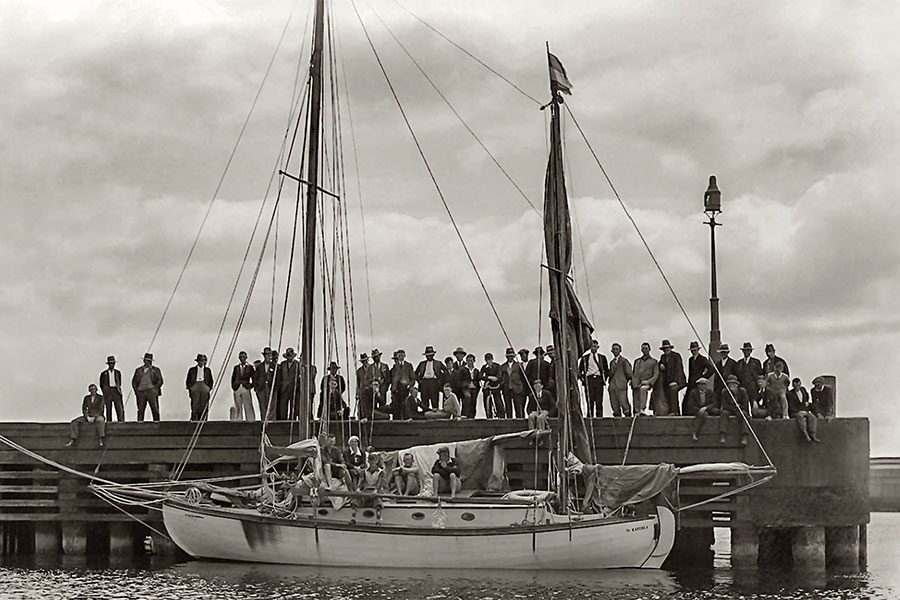

Passion seems a strong emotion to apply to outboard engines – but it certainly applies to the members of the Antique Outboard Motor Club Incorporated (AOMCI).
We’re worldwide,” New Zealand club member Monty Jones says, “swapping parts or advice – there are antique outboard motor fans all over the place.”
The New Zealand ranks are getting a bit thin though: “We’re down to about six members,” he adds, “from Lumsden [Otago], Whitianga and Auckland.”
Thousands of boating people thronged their stand at this year’s Hutchwilco Boat Show but with just two people on hand to answer questions it was exhausting.
“We had to take a week off afterwards to recover. But that’s one of the great things about these outboards – every motor has a story.” And it’s hard to tell which he and fellow member, Don Stewart, like best – the motors – or the stories.
“People turn up with all sorts of motors – and all sorts of stories,” says Don. “It takes a while to dig through the archives and verify them.”

No such problem with Monty’s 1947, 3.6hp Scott Atwater which his father bought in Christmas 1954 from a boat rental business on Lake Taupo. In the winter they took it back to Auckland for an overhaul and used it the next summer for trolling trout on the lake. It was stored again until 1959 and then used on a 14ft Hartley runabout that 16-year old Monty, Don (15) and another mate built – and which Monty still owns and uses regularly.
“Don and I were school mates at St Kentigern – and we built the boat together with one other guy,” Monty says. Larger motors were fitted to the Hartley and the Scott Atwater became an auxiliary again for trolling trout.
“The agents decided to clear their stock of spare parts in 1970 – so I bought what I needed.” He rebuilt the powerhead but the project ground to a halt until 1975 when Monty sought help from an AOMCI member in the UK – who sourced the parts he needed – plus a workshop manual. And he and Don joined AOMCI. There are AMOCI chapters in 11 countries – France, Germany, Hungary, Italy, Netherlands, NZ, Norway, Sweden, Turkey, the UK and USA.

“Luckily Dad was fairly mechanically-minded – so I inherited his lathe – and made what parts I needed on that.”
Finally, in 2016, the little outboard was refinished, painted and the transfers he’d bought for it in 1970 were applied so it could take pride of place at the AOMCI New Zealand boat show line-up.
Not bad for a man who’d spent 46 years in banking with ASB. Monty still owns the Hartley, named Polaris, and regularly uses her.
“There’s outboards all over the place,” he says, “but we are really the wrong age group to be doing this – it would be good to get some younger guys on board.
“The first thing we do with an outboard, is to make sure it’s not seized and check the compression. It’s too expensive to do a rebore these day with the cost of pistons and rings etc. It pays to check the lower unit first – sometimes it will be seized – but the motor’s OK.
“A problem with outboards in New Zealand is that we’re surrounded by salt water and if motors aren’t well maintained they corrode away. In places like the USA they have huge areas of fresh water for boating and motors last a lot longer.”
Ole Evinrude, a Wisconsin do-it-yourselfer is said to have invented the outboard motor. The story goes that he and his girlfriend were relaxing at a lakeside in the US when the girlfriend decided that she’d like an ice cream.
Evinrude jumped into their rental rowboat and set out across the lake to the nearest shop but, by the time he got back, the ice cream had melted so he decided to build a motor that would get him back quicker with the ice cream intact.
Pride of place at the 2019 show was the line-up of elderly Evinrudes. The 14 models on display date from 1913 to 1975, celebrating the marque’s 110 years of manufacture.
“At one stage we had one of the ELTO’s (Evinrude Light Twin Outboard) set up in a drum of water so people could have a go at starting it. They’re a particularly easy motor to start – it was interesting to watch – specially the women. A lot of them just didn’t believe they could do it and they’d break into smiles when the motor started – some had to do it twice just to make sure.”
The ELTO also predates swivelling motors and has a fixed propeller with large cast rudder attached.

Another motor in the AOMCI line-up is possibly the world’s slowest Indian: a 1930, 10hp model. It is one of the most sought-after motors in antique outboard collecting circles, Don says, and the one at the show had been loaned by the New Zealand Maritime Museum.
“The Indian Silver Arrow outboard was made by the Indian Motorcycle Company of Springfield, Massachusetts and was only made in 1930,” he explains.
“Indian bought a Hartford sturdy Twin, design and machining, from Gray & Prior Machine Company and spent the latter part of 1929 designing the large fancy muffler which probably did more to damage a good running outboard than improve it.”
About 1500 Silver Arrow outboards were made in 1930-31 before Indian decided to return to its core business of motorcycle manufacture. “The cast Indian motor stand supplied to dealers is also extremely rare,” he adds. “Probably rarer than the motors.”
Another rarity on the stand was the Dolphin – the only outboard ever built in New Zealand. It was built by Crowe Industries in Hamilton whose stock in trade was the country’s first rotary lawn motor. In the 1950s the company’s proprietor, Charlie Crowe, got another Hamilton business to cast the outboard lower units in aluminium and owners could swap the US made Clinton 2.5hp from the mower to the outboard. The combined unit sold for £88 and 15 shillings ($177.25).
In the late 1950s a 3hp Iron Horse motor was incorporated and later models used a 5.4hp Australian-built Kirby power plant.
An AOMCI member flew in from the US and bought Don’s rare and treasured 1950, 14hp Anzani Sports Twin Racer which had the same ‘boxer’ motor configuration familiar to BMW motorcycle fans. It weighed 39kg.
These days his collection has been bolstered by an Australian (Tornado) Trojan motor made by Seacraft in Mordialloc, Victoria between 1952 and 1960. Powered by a 75cc British-built Trojan Cyclemotor with an Amal carburettor and Wico magneto, it was promoted as the most efficient and lightweight motor available at the time, says Don.
Another rarity is a Swedish Trim motor and some very long-in-the-teeth Tohatsus.
New Zealand Government policy favoured Britain as a trading partner and, for a long time, the ubiquitous British Seagull was the only motor available. One example at the show was dredged up after years immersed in seawater, and Monty tackled a rebuild on another with a seized drive unit.

“I rang John Crichton, who specialises in rebuilding them,” he recalls. “His first advice was ‘go and get yourself a book of swear words…’” But using a self-made jig, Don managed to free the drive gears.
“Sometimes you have to think outside the square,” he says. “It depends how far you want to go – we spend hours on them.
“It’s crazy really.”




